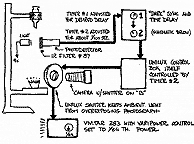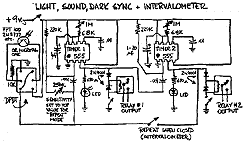|
Andrew Davidhazy, Professor
Making a photograph of something as simple as the splash of a water drop as it impacts a liquid surface may seem easy but there are a number of things which soon become apparent and which make the process much more complicated than it first appears. Basically, you need to simply activate the shutter of the camera at the time the splash takes place. But... ... since the event is so unpredictable in when it exatly happens, one finds out that this can not be done manually. To top it off, the splash lasts a very short time and if we want a blur free record this also imposes certain other requirements. Intuitively we realize that an automatically activated camera or flash is needed. However, not only does the event last a short time, it also moves at a high rate of speed. Due to this the use of a camera is not possible because it is not capable of a short enough exposure time. A short duration electronic flash is required to achieve sufficiently sharp photographs. To set the flash off at the right time, an electronic delay must fire the flash after the correct amount of time has elapsed from the time the drop crosses a light beam and is detected by a "dark" activated synchronizer. This method might be called the "standard" (or "Edgerton") method of making splash photographs and it works well if the experiment is conducted in a dark room. In darkness one opens the cameraŐs shutter, waits for the flash thus making a photograph and then one closes the shutter before turning the room lights back on.
The cameraŐs shutter, however, is closed until one is ready to make an exposure at which time, the shutter set on "B", is opened just previous to a drop falling from the applicator. Since the capping shutter at this time is closed the film will not be exposed. The drop eventually passes through the light beam interrupting the light to the detector. This causes the time delay to start timing and after the desired delay it triggers the electronic shutter for about 1/100th of a second. This time is short enough to preclude ambient light from pre-exposiong the film. Upon this shutter reaching the fully open state, itŐs "X" sync in turn triggers the electronic flash connected to it and this makes an impression on the film just before the capping shutter closes again. One needs to simply close the camera shutter before the arrival of the next drop to ensure that only a single exposure is made on a sheet of film. The Vivitar 283 electronic flash is made to produce a short duration flash by quenching the
circuit at 1/64th power giving an approximate 1/2 peak duration of about 1/20,000 second.
The schematic and parts list for the Light, Sound and Dark activated synchronizer and time delay/intervalometer are provided above. The electronic shutter provided by the Unilux Corporation is of 25mm clear aperture. Timer One of the time delay is used to delay the operation of this shutter so it opens at the appropriate time. The length of time that the capping shutter stays open is controlled by a relay controlled by Timer Two of the time delay circuit. The film used for this demonstration is 3000 speed Polaroid Type 667 which does not need coating after exposure. ItŐs processing time is about 40 seconds. It was generously supplied by the Polaroid Corporation. If you have any questions about this demonstration contact Prof. Andrew Davidhazy,
Rochester Institute of Technology, 70 Lomb Memorial Drive, Rochester, NY 14623 (585) 475Ń2592
or send me email at andpph@rit.edu.
|

